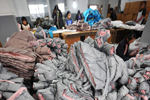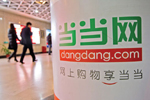Urbanization to engine China's economy
Updated: 2012-02-15 15:17
(Xinhua)
|
|||||||||
CHANGYUAN - The Chinese government is building new cities in the country's underdeveloped interior, hoping to convert millions of farmers into city dwellers and maintain China's burgeoning economic success in the following decades.
Along the mud-clogged Yellow River, a local government has widened crooked country lanes into highways, turned farmlands into housing estates and invited Nike and Adidas to open stores in a nearby shopping mall.
In Changyuan, a county with 840,000 inhabitants in central China's Henan province, ambitious officials, keen business people and restless farmers are working together to urbanize the sleepy rural region.
From the balcony of his daughter's new apartment, a cluster of newly finished buildings unfurl in front of 65-year-old Wen Xianhua. Those were patches of wheat when he came last time.
It's been six years since Wen last visited the county seat, during which time dozens of villages have been turned into urban areas.
A report released in January by the National Bureau of Statistics stated that 51.27 percent of China's total population was located in urban areas as of the end of 2011, meaning that over the past three decades, more than 500 million people have been added to China's cities, especially large ones in prosperous coastal areas.
According to the estimation of business counselor McKinsey, there will be one billion people living in China's cities by 2030. This means more than 300 million new urban residents - almost as big as the current population of the United States.
However, a blue book on international urban development published last Thursday warns that the fast growing population has overwhelmed the insufficient infrastructure of China's big cities. The blue book done by China's top think tank, the Chinese Academy of Social Sciences, says problems like traffic jam and pollution might become even worse in the coming years.
Zhuang Jian, a senior economist from the Asian Development Bank, said the next phase of China's urbanization will feature a focus on medium- and small-sized cities, with less attention paid to the country's metropolitan areas.
The government is working to urbanize rural areas, generating demand for road construction, telecommunications services and other infrastructures essential to cities.
Wen Xianhua's eldest daughter, Wen Yuling, moved to Changyuan's county seat over the winter. Despite having lived in the countryside for the last 35 years, Wen Yuling has her apartment decorated much as a typical urban resident would, with hardwood floors, a glass coffee table and new air conditioners.
Supplying elevators, washing machines and supermarkets for new communities will create a massive new market, with large numbers of migrants expected to move to newly urbanized regions.
Wen Yuling's brother, Wen Qiang, is also planning to follow her suit. With an annual income of 80,000 yuan (about 12,700 U.S. dollars), he has been looking for an affordable apartment and has visited four housing estates during the Spring Festival holiday at the end of January.
"My eldest son will get married within the next few years. Many young women would like to find a husband who has an apartment in the city," he said.
Like most migrant workers in China, Wen Qiang works thousands of miles from his hometown, earning ten times more than he would on the farm. But the high costs of city life, as well as problems with China's household registry system, have prevented his family from joining him in the city.
His wife stays on the farm and takes care of their two sons. But they don't want their sons to stay in the village for the rest of their life.
"People used to build big houses in the village when they earned enough money working outside," Wen Qiang said, "but things are different now. Villagers from my generation want to buy apartments in cities. There are better schools, bigger hospitals and shopping malls.... It's more convenient."
According to Wang Yantao, deputy director of Changyuan's publicity department, one fourth of Changyuan's 840,000 residents work outside the county, while local private companies and factories have attracted 165,000 surplus agricultural laborers. The local government wants to encourage them to move to the county's urban areas.
Entrepreneurs see limitless opportunities in this process. Encouraged by the local government, keen business people have brought city life to local farmers, constructing high-rise buildings with heating systems, shopping malls, theaters, advanced hospitals and schools that provide kindergarten to high school education.
"These are the reasons I've moved here," said Zhang Shengchang, a 29-year-old resident of Changyuan's county seat. Having lived there for six years, Zhang drives out of town to work in the countryside, while his wife stays home to take care of their two children who attend a public primary school.
"There are 2,000 families in my community. More than half of them came from villages," Zhang said, adding that all his three sisters have moved to the county seat over the last three years.
Every year, about 4,000 rural residents move to the county seat, while another 6,000 move to another 10 towns of the county. These newly urbanized families tend to spend more money in their city homes than they do in the village.
In 2011, retail sales of consumer goods in Changyuan reached 3.85 billion yuan, up 18.7 percent year-on-year.
Zhuang Jian said urban residents tend to consume three times as much as rural residents, a fact that will lead to great expansion in domestic demand. The government is looking to domestic demand to stimulate the country's economy in light of weak export prospects and the financial crisis in Europe and the United States.
Related Stories
China sets targets for Urbanization 2001-08-07 15:35
China sets goal for urban unemployment 2011-12-17 07:24
Urbanizing China 2010-12-31 08:46
- Yuan appreciation won't help foreign firms: study
- Li calls for push toward resource savings
- Wal-Mart aims to beat industry growth pace
- COMAC to sign key suppliers for C919 by June
- Firm tries to block iPad on mainland
- DBS readies 'dim sum' bonds
- Beijing lends a hand to debt-ridden Europe
- Talks on mega-carrier access open in Brazil









